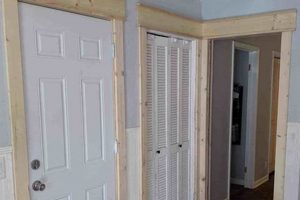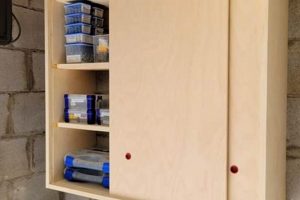The act of independently installing or modifying a door’s security mechanism encompasses a range of activities, from simple lock replacements to more complex security system integrations. This often involves individuals taking on tasks traditionally performed by locksmiths or professional installers. Examples include installing a new deadbolt, adding a smart lock, or reinforcing a door frame to enhance its resistance to forced entry.
Pursuing security enhancements independently offers several advantages. It can reduce costs associated with professional services and provide a customized solution tailored to specific needs and preferences. Historically, homeowners have undertaken such projects to improve their sense of safety and control over their living spaces. The increased availability of instructional resources and affordable security hardware has further propelled this trend.
The following sections will delve into the various aspects of door security enhancements, covering topics such as selecting appropriate hardware, understanding different locking mechanisms, and implementing effective installation techniques. The aim is to provide a comprehensive overview of the knowledge and skills required to implement effective security measures independently.
Enhancing Door Security Independently
Implementing effective security measures requires careful planning and execution. These tips offer guidance on maximizing the effectiveness of door security enhancements.
Tip 1: Hardware Selection. Prioritize quality materials. Opt for deadbolts with hardened steel bolts and reinforced strike plates. Avoid inexpensive hardware that may be easily compromised.
Tip 2: Frame Reinforcement. The door frame is often a weak point. Install reinforcing plates or longer screws to secure the strike plate to the door frame’s stud. This increases resistance to forced entry.
Tip 3: Hinge Security. Ensure hinges are securely fastened and consider using security hinges with non-removable pins. This prevents door removal by dislodging hinge pins.
Tip 4: Smart Lock Integration. If integrating smart locks, ensure the chosen model is compatible with the existing door and frame. Regularly update the lock’s firmware to address security vulnerabilities.
Tip 5: Key Control. Maintain strict control over key duplication. Consider using restricted keyways that require authorization for key duplication.
Tip 6: Visual Deterrents. Install a wide-angle peephole or a video doorbell to monitor activity outside the door. Visible security measures can deter potential intruders.
Tip 7: Professional Consultation. While implementing improvements independently, consult with a qualified locksmith for complex installations or security system integrations. Professional advice can ensure optimal security.
Adhering to these guidelines enhances the overall security posture of entry points and contributes to a more secure environment.
The subsequent section will explore advanced security measures and discuss the limitations of independently implemented solutions.
1. Hardware Quality
The selection of appropriate and robust hardware is paramount when independently enhancing door security. Compromises in hardware quality can undermine even the most meticulous installation efforts, rendering security measures ineffective.
- Material Composition
The materials used in lock and door components directly influence their resistance to physical attacks. Hardened steel, brass, and other durable alloys offer superior protection against forced entry compared to less robust materials like zinc or aluminum. For instance, a deadbolt made of hardened steel is significantly more resistant to sawing or drilling attempts than one made of a softer metal.
- Locking Mechanism Complexity
The internal design of a lock determines its resistance to picking and bumping. More complex locking mechanisms, such as those found in high-security deadbolts, incorporate features like anti-pick pins and drill-resistant cylinders. These features substantially increase the difficulty of unauthorized entry. A basic pin tumbler lock, in contrast, is generally more vulnerable to compromise.
- Strike Plate Reinforcement
The strike plate, the metal plate attached to the door frame where the lock bolt engages, is a crucial element of door security. A weak or poorly installed strike plate can be easily defeated with a forceful kick or shoulder strike. Reinforced strike plates, often featuring longer screws that penetrate deep into the door frame’s stud, provide significantly enhanced resistance to forced entry. Example: A standard strike plate is secured with short screws into only the door frame trim, while a reinforced plate uses 3-inch screws to fasten directly into the structural stud.
- Hinge Security
The hinges are often an overlooked vulnerability. Standard hinges with removable pins can be easily defeated by removing the pins and allowing the door to be swung open. Security hinges with non-removable pins or hinge bolts provide enhanced protection against this type of attack. Example: Doors that swing outward require additional security around the hinges.
The cumulative effect of these factors demonstrates that hardware quality is not merely a matter of aesthetics or cost. It is a fundamental determinant of the overall security provided by independent door security enhancements. Neglecting the quality of hardware can render even the most ambitious security projects ineffective.
2. Installation Accuracy
Precise execution during the implementation phase is crucial for realizing the intended security benefits of independent door security modifications. Deviations from recommended installation procedures can significantly compromise the effectiveness of security enhancements, irrespective of the quality of materials employed.
- Proper Alignment
Accurate alignment of the lock mechanism, strike plate, and door frame is essential for the lock to function correctly and securely. Misalignment can result in a weakened locking point, rendering the door vulnerable to forced entry. For instance, a strike plate that is not precisely aligned with the deadbolt can prevent the bolt from fully extending, reducing its holding power. A real-world example involves doors where the strike plate is visibly off-center, allowing the door to be forced open with minimal effort. Similarly, a smart lock system must be accurately aligned and calibrated to function reliably.
- Correct Fastener Usage
Employing the correct type and size of fasteners is vital for ensuring the stability and strength of security hardware. Using screws that are too short or of insufficient strength can compromise the ability of the lock and strike plate to withstand force. For example, securing a strike plate with short screws that only penetrate the door frame trim provides minimal resistance to a kick-in attack. Conversely, using long, heavy-duty screws that extend into the door frame’s structural stud significantly enhances security. The length, gauge, and type of screw must be appropriate for the material being fastened.
- Precise Mortise and Bore Hole Dimensions
When installing new locks or deadbolts, accurate mortise and bore hole dimensions are essential for proper fit and function. Oversized or undersized holes can create weaknesses in the door and compromise the integrity of the locking mechanism. An improperly sized bore hole, for instance, can lead to a loose or unstable lock cylinder, making it easier to tamper with or bypass. Precision is crucial to ensure that the lock fits snugly and securely within the door. The manufacturer’s installation instructions must be adhered to when drilling door holes and mortising for lock bodies.
- Adherence to Manufacturer Specifications
Each security device is designed with specific installation parameters in mind. Deviation from these guidelines can void warranties and, more critically, introduce vulnerabilities. Following the manufacturer’s instructions ensures optimal performance. For example, a smart lock requires careful calibration of its sensors to detect door status accurately. Improper calibration can lead to false readings and unreliable operation. Many manufacturers offer resources such as installation videos, downloadable manuals, and customer support to guide users through the process and avoid errors.
The factors highlight the critical role of precise execution in maximizing the effectiveness of independent door security upgrades. A meticulously planned and executed installation process serves as a foundation for long-term security and peace of mind, while shortcuts or negligence can nullify the benefits of even the most advanced security hardware. A common mistake is neglecting to adequately reinforce the door frame after a new, better lock is installed, making the door frame the new weak point.
3. Frame Integrity
The structural soundness of the door frame is a fundamental element in the overall security of any entryway, particularly when security enhancements are independently implemented. A robust locking mechanism is rendered ineffective if the frame itself is vulnerable to forced entry. Therefore, maintaining frame integrity is paramount in all security upgrade endeavors.
- Material Composition and Construction
The material composition and construction methods used in the door frame directly impact its resistance to physical attacks. Solid wood frames, particularly those made from hardwoods, offer greater resistance than frames constructed from less durable materials like hollow-core wood or composite materials. The way the frame is assembled also influences its strength. Mortise and tenon joints or reinforced miter joints provide greater structural integrity compared to simple butt joints. For instance, a door frame made from solid oak with mortise and tenon joints is far more resistant to being kicked in than a frame made from hollow-core wood with simple nailed joints. A practical example is how police reinforce doorframes when executing search warrants.
- Strike Plate Mounting and Reinforcement
The manner in which the strike plate is mounted to the door frame is a critical determinant of its resistance to forced entry. A strike plate secured with short screws that only penetrate the door frame trim provides minimal resistance to a forceful kick. To enhance security, the strike plate should be mounted with long, heavy-duty screws that extend into the door frame’s structural stud. Reinforcing plates, which are metal plates installed behind the strike plate, can further enhance the frame’s resistance to forced entry. An illustrative scenario involves a door with a standard strike plate being easily defeated with a single kick, while a door with a reinforced strike plate and long screws requires significantly more force to breach.
- Hinge Reinforcement and Security Hinges
The hinges are another area of potential vulnerability. Standard hinges with removable pins can be easily defeated by removing the pins and allowing the door to swing open. To address this vulnerability, security hinges with non-removable pins or hinge bolts can be installed. These features prevent the pins from being removed, thereby preventing the door from being opened by removing the hinge pins. Alternatively, reinforcing plates can be installed behind the hinges to strengthen the frame’s resistance to forced entry. Consider a scenario where a burglar can easily remove the hinge pins on a standard door, while a door equipped with security hinges remains securely in place.
- Frame-to-Wall Attachment
The method by which the door frame is attached to the surrounding wall also influences its overall integrity. A frame that is loosely attached to the wall is more susceptible to being forced open. To ensure a secure attachment, the frame should be securely fastened to the wall studs using long screws or bolts. Gaps between the frame and the wall should be filled with shims and sealant to provide additional support. A practical example is a door frame that is loosely attached to the wall being easily pried open with a crowbar, while a securely attached frame requires significantly more force to breach.
The factors underscore the importance of addressing frame integrity when implementing security improvements. A robust door frame, securely attached to the wall and reinforced with appropriate hardware, provides a strong foundation for all security measures. Neglecting frame integrity can render even the most sophisticated locking mechanisms ineffective, highlighting the necessity of a holistic approach to door security enhancement. Ignoring the wall behind the doorframe can be another area of weakness. A lock will only be as good as the frame it is locking to.
4. Security Understanding
A foundational comprehension of security principles is paramount when undertaking independent door lock and security enhancements. This understanding dictates the effectiveness of chosen measures, influencing decisions ranging from hardware selection to installation methodologies. Lack of sufficient knowledge can render even the most expensive components ineffective or introduce unforeseen vulnerabilities.
- Lock Mechanism Vulnerabilities
A comprehensive security understanding necessitates familiarity with common lock bypass techniques, such as lock picking, bumping, and forced entry methods. Without this knowledge, individuals may inadvertently choose locks that are easily compromised or install them in a manner that exposes weaknesses. For example, a basic pin tumbler lock may be easily picked by someone with rudimentary skills, while a lock with advanced security features, such as anti-pick pins and drill-resistant cylinders, offers significantly greater resistance. Ignoring these vulnerabilities can lead to a false sense of security. Criminals often target homes and businesses that exhibit vulnerabilities through poor security designs.
- Door and Frame Weak Points
Understanding the inherent weaknesses of doors and frames is crucial for effective reinforcement. A solid steel door provides a higher level of protection than a hollow-core wood door, and a reinforced door frame is significantly more resistant to forced entry than a standard frame. Knowledge of common attack points, such as the strike plate area and hinge side of the door, allows for targeted reinforcement measures. For instance, installing a reinforced strike plate with longer screws that penetrate deep into the door frame’s structural stud can significantly enhance resistance to kick-in attacks. Overlooking these weak points can make the door vulnerable, even with a high-quality lock installed.
- Hardware Selection Criteria
Security understanding informs the selection of appropriate hardware based on specific security needs and risk assessments. Factors such as material composition, locking mechanism complexity, and resistance to physical attacks should be considered. A homeowner in a high-crime area may opt for a high-security deadbolt with hardened steel components and anti-pick features, while someone in a low-crime area may choose a standard deadbolt. Understanding the trade-offs between cost, security, and convenience is essential for making informed decisions. Many independent security modifications fail because an inappropriate lock was selected for the needs of the homeowner.
- Installation Best Practices
A solid understanding of security principles dictates adherence to installation best practices to ensure the effectiveness of security enhancements. Proper alignment of lock components, correct fastener usage, and precise mortise and bore hole dimensions are essential for optimal performance. Deviations from recommended installation procedures can compromise the integrity of the locking mechanism and create vulnerabilities. For example, using short screws to secure a strike plate can render it easily defeatable. Likewise, ignoring manufacture’s recommendations will compromise the long-term viability of the security enhancement. It is crucial to carefully follow manufacturer’s instructions.
The preceding points illustrate the integral role of security understanding in determining the success of independently implemented door lock and security enhancements. A comprehensive grasp of security principles enables individuals to make informed decisions, select appropriate hardware, and implement effective installation techniques, ultimately enhancing the security of their homes and businesses. Lacking this understanding, DIY security measures can be ineffective or even counterproductive, creating a false sense of security while leaving vulnerabilities unaddressed. A security understanding, or lack thereof, separates success from failure with security modifications.
5. Maintenance Regularity
Consistent maintenance is a critical determinant of the long-term effectiveness of independently implemented door lock and security systems. The absence of scheduled inspections and upkeep can lead to a gradual degradation of security, irrespective of the initial quality of materials or installation precision. For instance, a deadbolt mechanism that is not periodically lubricated may become stiff or seize, hindering proper engagement and potentially creating a vulnerability that can be exploited. Hinges, similarly, can develop rust or loosen over time, compromising the structural integrity of the door. A common example is a key that, over time, becomes difficult to insert or turn in the lock cylinder, signaling the need for lubrication or potential lock repair. Regular maintenance allows for early detection of potential issues and ensures the continued functionality of the door security system.
The practical significance of maintenance regularity extends beyond basic functionality. Scheduled checks provide an opportunity to identify signs of tampering or attempted intrusion. Scratches around the lock cylinder, damage to the door frame, or loose screws can indicate that someone has attempted to compromise the door’s security. Prompt detection of such signs allows for timely repairs and reinforcement, preventing potential future breaches. Furthermore, maintaining accurate records of maintenance activities, including dates of inspection, repairs, and replacements, can be invaluable in the event of a security incident. This record can assist law enforcement investigations and provide evidence of due diligence in security management. Example: A broken window near the door, along with scratches near the keyhole, can indicate the work of criminal, that a homeowner can report to police.
In summary, the relationship between maintenance regularity and independently implemented door security is one of direct causality: consistent maintenance preserves and enhances security, while neglect erodes it. Challenges associated with maintenance regularity include the time commitment required for inspections and repairs, as well as the potential cost of replacement parts. However, the benefits of maintaining a robust and functional door security system far outweigh these challenges. Adhering to a maintenance schedule, whether implemented personally or through a professional locksmith, is an essential component of a comprehensive security strategy. This ensures a long-lasting security measure.
Frequently Asked Questions
This section addresses common inquiries related to independently implementing door security measures. The information provided aims to clarify prevalent misconceptions and offer guidance on best practices.
Question 1: Is independent door security enhancement a cost-effective alternative to professional locksmith services?
Independent implementation can reduce immediate costs. However, potential long-term expenses associated with improper installation, hardware failure, or inadequate security should be considered. Professional locksmiths offer expertise and warranty-backed services, which may mitigate future risks. The cost-effectiveness depends on the individual’s skill, risk tolerance, and the complexity of the security needs.
Question 2: What are the primary risks associated with independently installing or modifying door locks?
The main risks include improper installation leading to compromised security, selection of inadequate hardware that is easily bypassed, and potential voiding of manufacturer warranties due to non-professional installation. Further, insufficient understanding of security principles can result in overlooking critical vulnerabilities. It is important to ensure the project is completed to a high-quality standard, or a professional is used.
Question 3: How can the quality of security hardware be assessed independently?
Hardware quality can be assessed by examining material composition (e.g., hardened steel vs. brass), seeking recognized certifications (e.g., ANSI grades), and reading independent product reviews. Reputable manufacturers often provide detailed specifications regarding the materials and construction of their products. Consulting with a locksmith can also provide valuable insights.
Question 4: What tools are essential for independently implementing door security measures?
Essential tools typically include a drill with various drill bits, screwdrivers (both Phillips and flathead), a measuring tape, a level, a chisel, a hammer, and safety glasses. Depending on the specific task, additional tools such as a mortise chisel or a hole saw may be required. Quality and precision of such tools will greatly impact the DIY project.
Question 5: How frequently should independently implemented door security measures be inspected and maintained?
A visual inspection of door security measures should be conducted at least every three months. This includes checking for loose screws, signs of tampering, and smooth operation of the locking mechanism. Lubrication of moving parts should be performed annually, or more frequently if needed. A professional locksmith should be consulted for any repairs or replacements that are beyond the individual’s skill level.
Question 6: Does independently installing a smart lock void the warranty?
The effect on the warranty depends on the specific manufacturer’s policies. Some manufacturers require professional installation for warranty coverage, while others permit independent installation. It is essential to review the warranty terms and conditions before proceeding with independent installation. Failure to follow directions will also cause the warranty to become void.
In summary, independent implementation of door security enhancements can be a viable option, provided that careful planning, informed decision-making, and adherence to best practices are prioritized. Comprehensive understanding of security principles and the ability to accurately assess and address potential risks are crucial for ensuring the effectiveness of the implemented measures.
The subsequent section will delve into advanced security options and offer perspectives on when professional consultation is advisable.
Conclusion
The preceding sections have explored various facets of independently implementing door security enhancements. This included hardware quality, installation accuracy, frame integrity, security understanding, and maintenance regularity. These factors collectively determine the effectiveness of such undertakings. While independent implementation can offer cost savings and customization, it necessitates a comprehensive understanding of security principles and meticulous attention to detail. Areas of weakness are the structural integrity of the wall and door, along with the quality of the locks.
Ultimately, securing entry points is a critical aspect of overall safety. While “diy lock door” modifications can be a viable path, thorough assessment of one’s skills and a realistic appraisal of security needs are paramount. In situations involving complex security requirements or uncertainty about proper implementation, consulting with a qualified locksmith is strongly advisable. The ultimate goal is to create a secure environment. Prioritizing safety and security is an investment in long-term well-being.







